Durable but fragile: how to choose and care for a cast iron stove top
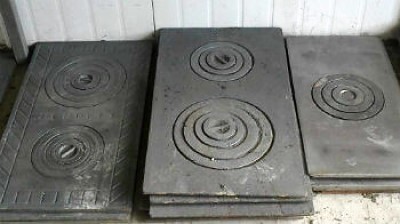
Cast iron cooking surfaces are used in wood-burning stoves. They serve for heating the room and cooking.
Cast iron has the ability warm up evenly over the entire surface and slowly release heat, heating the room.
Two types of cast iron stove plates
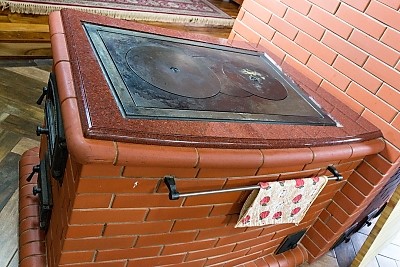
The material used for them is grey cast iron grade SCh. It is well cast into forms and has a sufficient margin of strength and elasticity. To improve the characteristics, it is added to the composition silicon, sulfur and manganese additives are added, and the carbon content is about 2%.
Iron casting not afraid of high temperatures And keeps its shape at any degree of heating. Surface does not oxidize or rust over time due to the strong oxide film formed during the casting process.
The slabs meet whole And collapsible. Disassemblable ones consist of several rings with a small thermal gap. It is necessary for correct compensation of the temperature regime.
Monolithic surface with burners
It's a one-piece casting sheet metal thickness not less than 8 mm. It can be equipped with fixed size burners (recesses or protrusions in places where food is prepared). Blind hobs do not have recesses. Hobs of this type the simplest in the installation and have low cost, so they are very popular in inexpensive ovens.
Important! Because of the fact that no open burners To heat up a kettle or saucepan, you have to heat up the entire stove, which is an extra fuel consumption.
Flaws solid slabs:
- inability to regulate temperature in the burner, you have to heat the entire surface;
- the absence of gaps makes the plate very sensitive to strong heat.
Dismountable cast iron structure
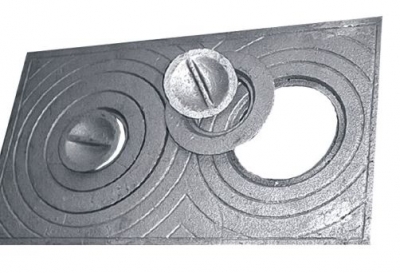
The design feature is several rings of different diameters, which fit into each other like a puzzle. By removing the rings, you can select the optimal burner caliber for a specific pot or frying pan.
This scheme gives a lot advantages before traditional:
- Tall reliability and rigidity surface. It is not afraid of heating due to the gaps between the parts of the burner, which protect the metal from deformation.
- Opportunity regulate the heating intensity by opening individual sections. Cooking takes place over an open fire and does not require heating the entire surface. This saves time and firewood.
Important! The cookware must be suitable for use over an open fire. The best ones for this are cast iron and aluminum cookware.
How to make a choice
You can buy a cast iron hob of imported production, for example, Finnish Pisla and HTT. Among domestic brands, the greatest demand is for products from NMK, SibStalShar, Litkom, Balezinsky LMZ.
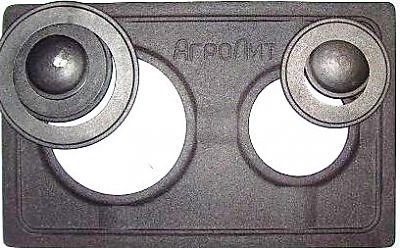
They all have a beautiful appearance, heat resistance up to 1000°C and environmentally friendly, not emitting harmful substances when heated.
The following standard dimensions are accepted for laying stove plates: 710x410 mm, 340x410 mm, 660x410 mm, 585x340 mm and others. Quantity burners on the typical section one or two.
Thickness cast iron in expensive plates reaches 12 mm, and the design itself has stiffening ribs on the back side. The weight is about 20 - 25 kg.
Installation rules
To ensure that the metal surface of a wood-burning stove lasts a long time, it should be sealing is carried out according to the following rules:
- When installing a stove in a brick oven, the different coefficients of thermal expansion of brick and cast iron are taken into account. It is enough to leave a gap of 5 - 7 mm around the perimeter, then it will not damage the masonry.
- For fixation use solution of clay and asbestos chips. It is made independently by grinding and mixing the components with water, or diluting the ready-made one from the store. The optimal consistency is considered to be liquid sour cream.
- Place a slab under the base soft backing made of asbestos cord or cloth.
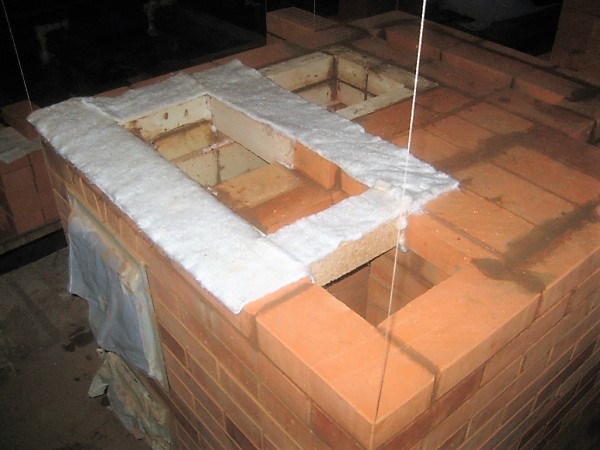
Photo 1. The underlay for the hob made of soft non-flammable heat insulator is laid directly on the brickwork.
- For reliability, the top row of masonry secured with a metal corner.
- Installation is in progress by level, and the largest burner is located above the main place of firewood combustion.
- After drying the oven solution is gradually heated to a temperature at 600 - 650 degrees gradually increasing by 70 - 80 degrees per hour. Such smooth heating will relieve internal stress in the cast iron and will not allow cracks to form during subsequent use.
Attention! To heat up start with small chips, gradually adding large ones logs. After heating to the required temperature, the oven is left until it cools completely.
Caring for your cast iron cooktop
Cast iron is a material unpretentious, but even he has his weak points. First of all, it is natural fragilityCareless handling of the plate and impacts lead to the appearance of cracks and chips on the surface. It is impossible to weld defects, so such a plate will have to be thrown away.
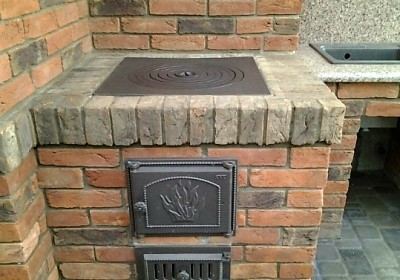
Hot plane sensitive to liquid contact. Rapid cooling of the slab may result in cracks appearing and the seal becoming unsealed.
Surface of the slab does not require additional processing any compositions. Quite regularly wipe a cold stove with a damp cloth, and burnt food residues are removed using hard brushThe rust deposits due to long periods of inactivity will come off immediately after the stove heats up.
Popular for surface cleaning folk methods: soda, soda with vinegar, ammonia and hydrogen peroxide, mustard powder. Do not use flammable liquids (solvents, acetone) and strong detergents containing acids. It is best to use mechanical cleaning methods various abrasive materials.
Useful video
Check out this video to see how to install a cast iron cooktop on a brick oven.
Safe Operation Rules
In handling cast iron plates of various designs they must not be allowed to overheat. For this purpose they use only firewood, in extreme cases - coalLiquid fuel is not suitable due to its high combustion temperature.
During the heating avoid sudden changes in temperature and mechanical impacts. Monitor integrity surfaces. Cracks cause carbon monoxide to enter the room and disrupt the normal operation of the stove.
Following these simple steps will allow you to use your stove with a cast iron hob for a long time without any problems.






Comments
Experienced cooks, when using such a stove, prepare many dishes when a small fire is simply maintained in the oven after it has warmed up, and sometimes not even maintained at all; the heat that the cast iron produces for a long time is enough for them.